Local historian: A guide to Exmouth’s churches
By Mike Menhenitt 29th Jan 2023
By Mike Menhenitt 29th Jan 2023

Holy Trinity Church
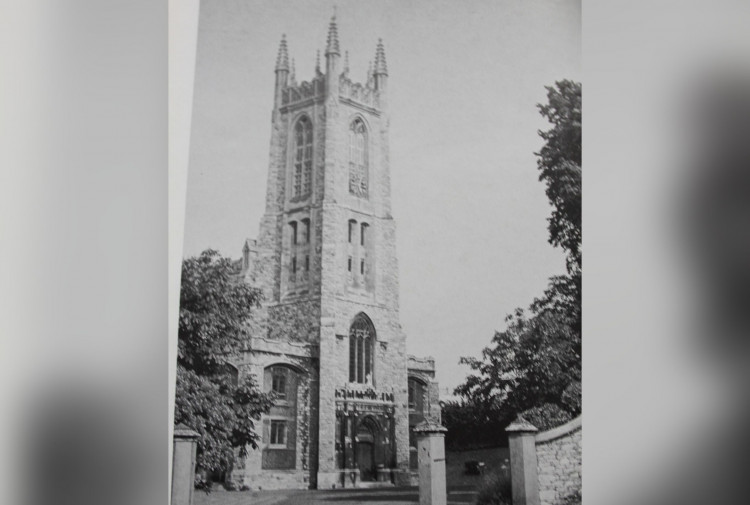
Holy Trinity Church is the largest church in Exmouth and is often mistaken by those not in-the-know as being the parish church of Exmouth.
There is of course no parish of Exmouth as the town is split between the historic parishes of Littleham and Withycombe Raleigh.
The former is sometimes referred to as Littleham-cum-Exmouth but historically Littleham is the correct term.
As early as 1412, there was the Chapel of the Holy Trinity which stood on top of Chapel Hill and was licensed by Bishop Stafford.
It had a tall tower and was easily visible from Tower Street, which is how that street got its name.
In 1779, the building was taken down, but the thatched cottages that were to the west side remained and was rebuilt and the first service in the new church was on 10 September of that year.
The Rev. Short was also in correspondence at that time with Earl of Buckinghamshire asking for the remainder of his donation, £100 as the church had been finished and they needed to pay the builder!
In 1798, Joseph Evans was employed to build the aisle of the church for £440 but by 1810 the church was found to be unsuitable for the ever-growing population of the town and the pulpit was moved to another part of the church to try and create more room and pews and private seats were created in the gallery.
At this time, the vicar was one John Rymer who came in from Littleham to take services.
He was a colourful character by all accounts, who had had an argument with his parish clerk at Littleham over fees for a wedding he was supposed to officiate over.
These had been paid to the clerk and not the vicar.
He duly threw off his surplice and refused to conduct the ceremony, which landed him in the Bishop's Consistory Court.
When preaching at Holy Trinity in 1808 he rebuked three girls, in mid-sermon, who were misbehaving and again found himself up before the bishop. A year later he died.
1823 saw the decision to rebuild Holy Trinity once again and a year later on its present site, in Beacon Fields the new church arose wholly paid for by Lord Rolle and consecrated by Bishop Carey.
The old barrel organ was still used however for another two years until a new organ was installed.
In 1856, the Rolle family very generously paid for the Chancel to be added. The old vicarage had been taken down too in 1826 and a new one built on the site of the old church in Chapel Hill.
In 1876, there was much controversy over the pews in the church and this was widely reported in the Exmouth Journal when it had been proposed that the pews be removed and replaced with chairs.
The church was now certainly large enough but was plastered outside which soon became somewhat dilapidated. In 1904, the vicar Rev. Freeman introduced a scheme for the rebuilding of the church once more.
These were enthusiastically received by parishioners and although the Rolle family paid for the bulk of it the local people raised a considerable sum towards the overall cost of about £35,000.
The new church was completed in its present form between 1905 and 1907. The Lady Chapel is a memorial to Lady Rolle.
It contained some splendid stained glass windows but during a German bombing raid on 12 February 1942 a lot of these were seriously damaged. Holy Trinity survived from further bomb damage and today plays a large part in the religious life of the town.
St Andrew's and St Saviour's Churches
Neither of the above churches are now in use in the town but in their time they played an important part in the religious life of Exmouth and therefore no story of Exmouth's churches is complete without including them.
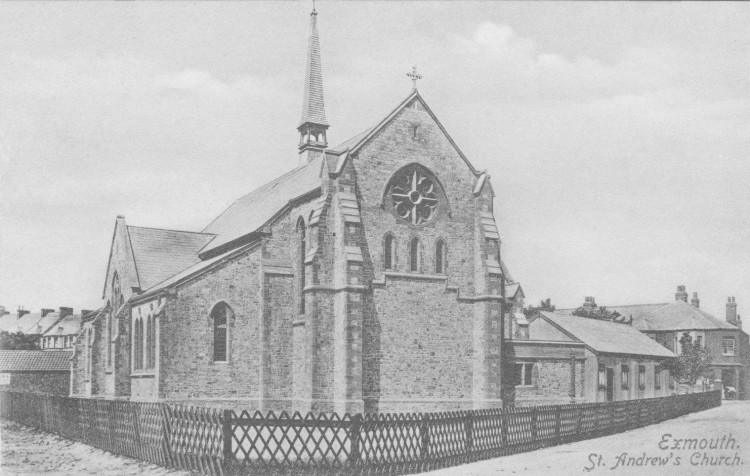
The first church on the site of St Andrew's in St Andrew's Road was a tin structure built in 1892 and known as "The Tin Tabernacle".
This was replaced in 1896 by a stone and red-brick church in the early English style with a central bell turret. The first service was held on 20 May in that year.
It could hold about 450 worshippers and was served by the clergy of Holy Trinity.
In July 1911, it was proposed to erect a screen which would add "to the appearance and devotional power of the church".
It was largely paid for by Dorcas Stewart in memory of her husband Rev. Herbert Stewart, who had retired to Exmouth from Yorkshire due to his health and who died in 1893 aged 35.
Besides worshipping at the church, she also gave inspirational talks there until she died in 1941 and the lectern was also paid for by her.
During World War Two, the church suffered damage during a bombing raid and in 1952 in the South Chapel a memorial window was created.
The last service was held there on Easter Day, 26 March 1989 and following this the Lady Chapel altar was moved to the Lady Chapel in Holy Trinity.
In 1995, planning permission was granted to convert the church into flats and it became St Andrew's House under Chapter One, a supported housing service in Exmouth.
Your historian is indebted to Norman Goodman, the late Nicola Clapp and to Yanick Munro for their assistance with the research into St Andrew's Church.
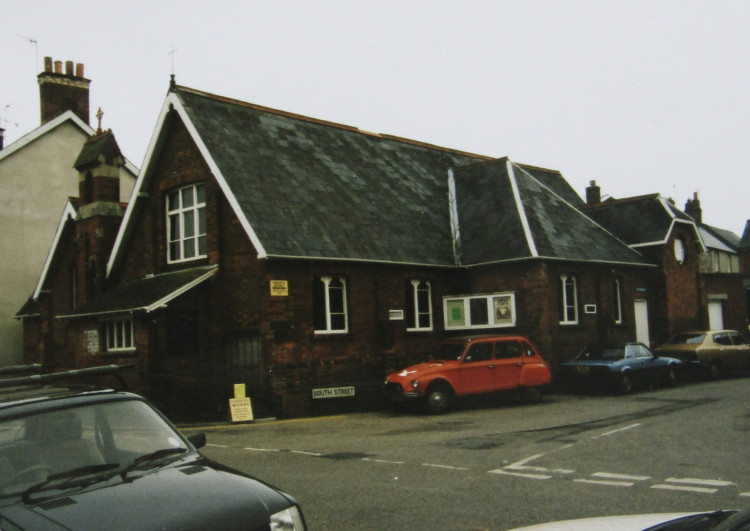
St Saviour's Mission Church was erected in 1881-2 on the corner of South Street and Church Street at a cost of £380.
It was built of red brick with a turret containing one bell and was served by the clergy of Holy Trinity.
It was further enlarged in 1888 and could then accommodate 250 worshippers.
Across the road from the church in 1914, The Exmouth Church Institute Parish Hall was built and later became St Saviour's Church Hall.
It featured a large kitchen which was later used as a soup kitchen when the Exmouth Market next door closed.
The final service was held in December 1988, and following this the church was later demolished. In 1996, The Open Door Centre was built on the site as a Christian charity. The church hall building is still there today and houses a row of shops and offices above.
Your historian extends his thanks to Norman Goodman and Yanick Munro for their invaluable assistance with the research into this church.
St John in the Wilderness Church
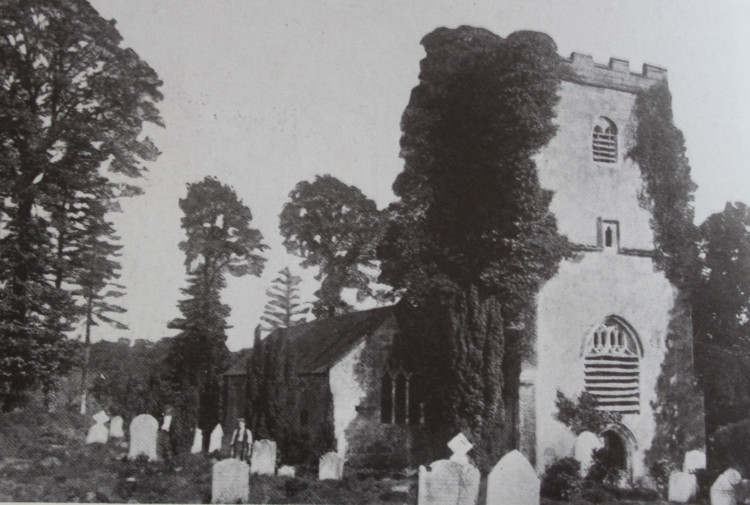
St John in the Wilderness Church, which is now in the parish of Withycombe Raleigh (the parish was only established in 1850), sits in one of the prettiest locations that any church could possibly be, beside a small lane in which there are some delightful houses, surrounded by fields.
A church has been here for over a thousand years and the present church originally dates from 1381–1435.
In Saxon times, the church was held by a woman, Alveva under the lordship of Gytha, mother of King Harold who was defeated by William the Conqueror at the Battle of Hastings. Following this, the church was given by William to William de Clavill.
Traces of this early church, probably a wooden structure with a thatched roof, have been discovered in the foundations of the present church.
From 1150, the manor of Withycombe was in the care of various religious orders and then purchased by the Raleigh family following the dissolution of the monasteries in 1538 by Henry VIII.
The church, which is dedicated to St John The Baptist, seems to have got The Wilderness part of its name from being so isolated and inaccessible as it was in 17th century.
By 1788, it had become very dilapidated and services ceased and as it was then in the parish of East Budleigh, the vicar there wanted it pulled down.
The Commons of Enquiry decreed that it only the nave and chancel be demolished and that two of its bells be sold to assist with the expenses of restoring the church. According to records, they were sold to an Exeter ironmaker for £74, 18 shillings and 6 pennies.
The north aisle and tower were saved from demolition and here are two memorial tablets to the Raleigh family, one in the north aisle and the other in the Lady Chapel which marks the place where George Raleigh was laid to rest in 1597.
In the corner is a small Norman column which was part of the early Norman church. On the wall of the stairs leading to a balcony there are two wooden panels, believed to be Victorian, depicting the Ten Commandments.
Over the years the church still decayed further and in 1850 it became part of the new parish of Withycombe Raleigh along with St John The Evangelist (the parish church) in Withycombe Village Road and All Saints Church on Exeter Road.
It was not until 1922 that it was finally decided to restore the church and some services started there again. The building work took place between 1926–1932 thanks to the generosity of parishioners and was finally finished in 1937.
Inside, the nave was rebuilt on its original foundations and has retained its 15th century font upon which is the earliest inscriptions on any item in Exmouth, "Y.911" carved on its base. The ground floor of the tower, which dates from the 14th century has a pillar with a Green Man and Tudor Rose carved on it.
Outside, the churchyard is both picturesque and peaceful.
Your historian's great-great-grandparents are buried there, as are three famous artists: Francis Danby, an Exmouth resident who died in 1861, William Holwell Carr who was vicar of Menheniot in Cornwall but whose parents lived in Exmouth and lastly Richard Thomas Pentreath, an artist of the Newlyn School who died in Exmouth in 1869.
Just outside the gate is a private burial ground of the Bryce family who owned the Bystock and Marley Estates.
If you have not visited this beautiful church you really must on a lovely sunny day – just go and sit in the churchyard and let the world go by!
Littleham Church
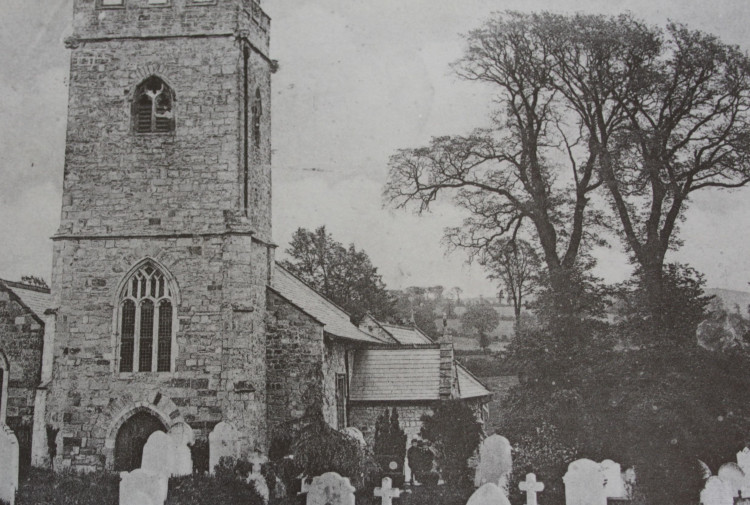
The Church of St Margaret and St Andrew's, Littleham can trace its origins back to Saxon times.
It sits in the historic part of the old village in a very pretty setting. The beautifully kept churchyard surrounding the church is a peaceful place to sit and contemplate.
Here you will find the grave of Viscountess Nelson, her tomb being surrounded by railings and accessed to the right of the path as you enter the churchyard. Her son is also buried here but the site of his grave is unknown.
Other famous people interred here are LCH Palairet, the famous Somerset and England cricketer and Daniel Warren of Minehead who was the first originator of the Submarine Telegraph.
Further away from the church is another part of the cemetery that has been allowed to grow wild and beyond that is a further one that is well kept.
Both these further cemeteries have wonderful views and can be accessed on Littleham Road from a lychgate about three hundred yards up from the church or by walking through the main lychgate that leads up to the church and then following the path.
From 1139, the monks of Sherborne served the parish.
During a vacancy at the Abbey in 1213, King John gave Littleham Church to Nicholas de Adham, a clerk at the abbey, for life.
As a result of this, in 1234 The Bishop of Exeter gave the church to the Dean and Chapter of Exeter Cathedral. Since then, the Bishop of Exeter has appointed all clerics at Littleham.
The present church can trace its history back to the 13th century and in the 16th century the Drake family of Pratteshayes paid for the addition of the North Aisle. The church was restored between 1883 – 1884 at a cost of £1660.
A Sunday school was established in 1820. The organ is by Norman & Beard.
As with all churches, tales abound of local characters and there are two in particular I will recount here.
Around 1780, at The First and Last Inn in Exmouth, a wager was made to one Tally Jack, an Italian, for a quart of cider that he would not go to Littleham and lie in a freshly dug open grave.
The thought of a free quart of cider proved irresistible to Jack and he accepted the bet.
He set off and unbeknownst to him the wager had been overheard by others in the inn and these men followed him to Littleham.
Jack duly arrived at the cemetery and having found a freshly dug open grave proceeded to lie in it. The men who had followed him found some shovels and having stealthily crept up to the grave started to fill it in.
Jack jumped out and the men dropped their shovels and fled and Jack chased them all the way back to the inn – there to claim his quart of cider!
The second tale is of one Lionel Bradford who it is said "saw a spirit rise from the grave".
He always whistled on his way across the graveyard on his way to work every morning.
Early one day he was taking his usual shortcut across the graveyard, whistling as usual, when a man's head popped up from a grave and said "What's the time, Lionel?".
Lionel, in horror, ran for all he was worth. Later that day on his way home he finally learnt that a villager, Jack Franks had had rather a lot to drink in The Plough the previous evening and while taking a shortcut home in the dark fell into the open grave and slept there.
Lionel's whistling woke him up and he popped his head up to get the time!
The churches of Withycombe Raleigh
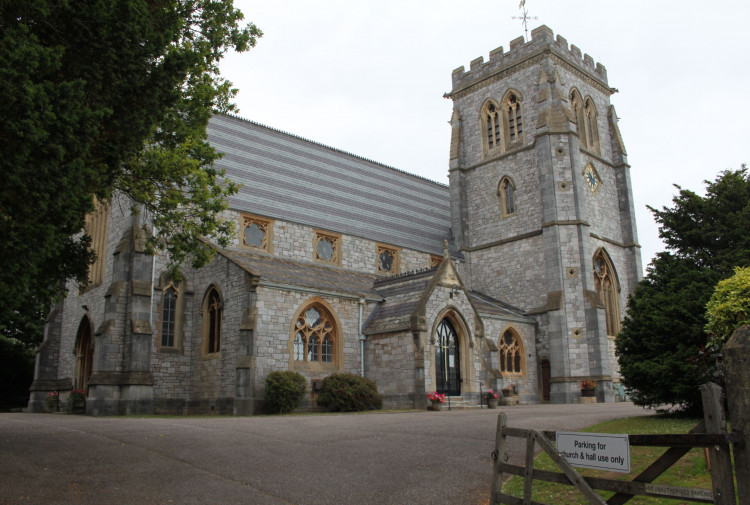
In the parish of Withycombe Raleigh there are three churches; that of St John the Evangelist on Withycombe Village Road, All Saints on Exeter Road and of course St John's in the Wilderness that was previously featured.
The parish of Withycombe Raleigh came into being in 1850 and prior to that was in the East Budleigh parish.
In 1421, Bishop Lacey gave a licence to the vicar of East Budleigh to hold services at St Michael and All Angels, Withycombe. This church was quite small and after 300 years was restored in 1722 due to the generosity of Sir John Colleton of Rill.
On the establishment of the Withycombe Raleigh parish in 1850 it was becoming evident that the existing church of St Michael and All Angels was too small to serve the ever growing population of the parish.
This small church survived until 1865 when it was demolished, but a sketch of it can be seen in the present day church that replaced it.
In 1850, the church of St John the Evangelist was started and it was consecrated in 1864.
Initially, the church of St John's in the Wilderness was the recognised parish church but in 1864 the new church in Withycombe Village Road became the parish church.
However, in 1912 it was discovered that due to an oversight in 1864 the church was not actually legalised for the purposes of conducting marriage ceremonies. A Special Order of Council was obtained that year to legitimise all marriages that had been conducted there between 1864 and 1912.
The church was built from local stone from Berry Head and Beer and the cost was £5,223 and both Lady Rolle and a Mr Wood of "The Grange" were major benefactors.
The church has a stained glass window, by Morris & Co and a 3 Manual Organ amongst its features. The bells were first added in 1889 and again in later years and are recognised as one of the finest in all Devon.
Usually, there is much history surrounding churches that historians spend time trying to discover and understand.
Regrettably, in the case of the newest church within the parish of Withycombe Raleigh, All Saints on Exeter Road, this is not the case.
This church came about due to a bequest of the late Miss Perrin of Llandovery House in Albion Hill and was commenced in 1898 and consecrated in 1908.
It is a traditional Anglo-Catholic church, featuring a Lady chapel in the south transept and a St Christopher altar in the north transept. If you can add anything further to the history of this church please do let your historian know.
The Roman Catholics in Exmouth
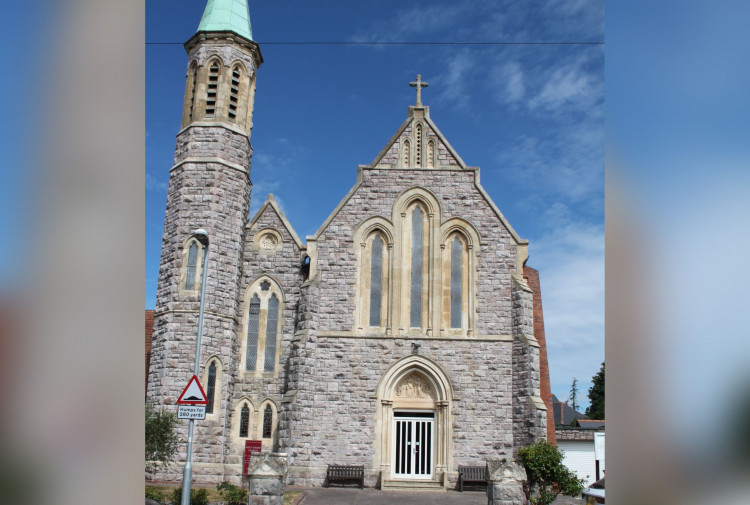
Following the dissolution of the monasteries by Henry VIII, and the establishment of the Church of England, many Roman Catholics worshipped secretly in fear of their lives.
After the long years of the Reformation, Holy Mass was said in Exmouth on 30 October 1887, attended by 14 people, at a private house called The Lawn, by the Rev. John Grainger, a nephew of the Archbishop of Glasgow, when he leased a room at this house which was used as a chapel. This later became the Park Hotel.
The following year, Father Grainger was appointed a Private Chamberlain to Pope Leo XIII.
In 1891, Father Grainger bought a house in Windsor Square and in the garden he had erected a corrugated iron chapel to meet the needs of the expanding population.
This house was later the district nurses' home but was destroyed by bombs in World War Two. The chapel later became the headquarters of the Girl Guides but it was destroyed by a fire.
Father Grainger died on 22 December 1898, and was buried in the vault of his mother's family in Eyres, Bath. He was notable for being the first rider of a motorcycle in Exmouth.
After he died, the Roman Catholics were served by the Austin Cannons from Spettisbury and then the Monks of Buckfast and then from Plymouth Cathedral until 24 March 1901 when Rev. Bernard Palmer was appointed the resident priest.
In 1912, Lord Clinton gave a site in Raddenstile Lane for a permanent church to be built and the Roman Catholic Church of the Holy Ghost was established there.
Due to the generosity of Mrs Maria Hamilton, the nave and the sanctuary were also added to the church. It was consecrated in 1914 and still serves the Roman Catholics in Exmouth and surrounding area today.
In 1967, Cannon O'Malley laid the foundation stone for a second Roman Catholic Church in Exmouth in Brixington Lane.
The first mass and blessing was by Bishop Cyril Restieaux on 27 August 1968 at the new Church of St Anne.
The land had been donated by two sisters, the Misses Payne who wanted the new church to be dedicated to The Sacred Heart.
However, such a dedication existed in Exeter, so St Anne was chosen as in 1413 the people of Withycombe had petitioned Rome for a "chapel of ease" under the patronage of St Anne to be built on the site of what is now Glenorchy Church. However, this chapel of ease was never built.
The hot water stoup in the new church was from the 14th century Votive Chapel of St Margaret of Antioch, rescued by Miss Peggy Jago when that part of Chapel Street was demolished to make way for the new Magnolia Centre. The new church cost £24,000.
However, in February 2006, the final mass was said there and the church closed as it was only being used for one hour each week and the church authority could not justify keeping two churches open in the town. It was eventually demolished.
The church in Raddenstile Lane was altered inside in 2007 with a new stone altar and ambro and sanctuary. St Anne's Cloister was completed in April 2008 and incorporates stained glass from St Anne's Church.
The Roman Catholic Community in Exmouth supported two schools: St Joseph's Primary School, which still educates children, and the Holy Convent Girls School, which closed some years ago.
Boys went to senior school at Winslade School at Clyst St Mary but this too closed some years ago, and in 1975 became offices for London and Manchester Assurance. It is still used now for offices for different companies.
The non-conformist churches of Exmouth
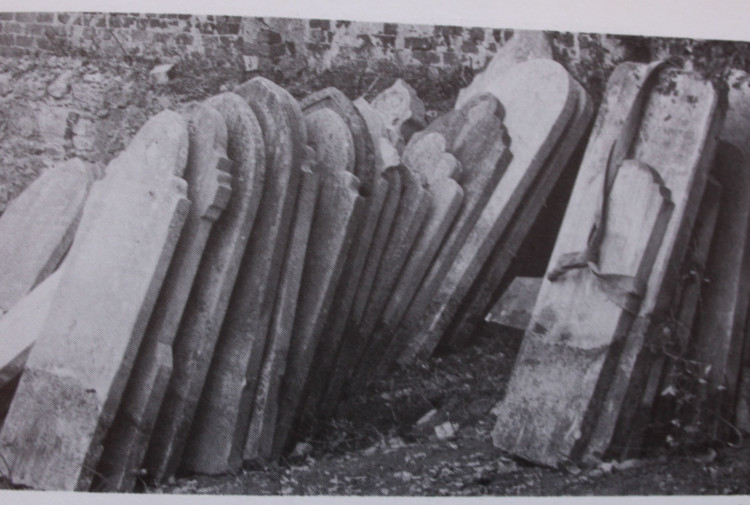
Exmouth is blessed with many religions being practised in the town - especially the number of non-conformist churches. These are defined as churches that dissented originally from the Catholic faith but later left the established Church of England.
The earliest of these Protestant religions was the Moravian Church, which in 1457 was established in Bohemia, now part of the Czech Republic.
Later, refugees from Moravia fled to Saxony where Count Nicholas von Zinzedorf allowed them to settle on land he owned near the Polish border. Moravians in Exmouth were linked to the Parminters of A La Ronde who served the church on one capacity or another.
Your historian's wife's own family are Moravians, with her family having been clergy in the church over three hundred years; her grandfather was a vicar and her uncle a bishop in the church. There is no Moravian church in the town, though.
Glenorchy Chapel is the oldest non-conformist church in the town, in Exeter Road.
It can trace its roots back to 1777, when it was founded by Lady Glenorchy in The Long Room at The Globe Hotel, where services were held until an ardent churchman, Samuel Eyre sent a gang of men to the landlord with the threat that he would lose his licence unless he banned the worshippers.
There was also the time that the press gang interrupted a service to steal men for the Royal Navy.
The church was then formally established by Lady Glenorchy who bought premises to have converted into a church. The present church was rebuilt in 1880.
The Baptists first came to Exmouth in 1891. The Salvation Army have their church in Sheppards Row. The Independent Evangelical Church is in Scott Drive, just off Hulham Road; The Community Church is in Market Street and the Quakers meet in Church Street. The Methodists also have three churches in the town.
Finally, we come to the Plymouth Brethren, who first met in Exmouth in 1843.
In 1854, a Zion Chapel was built in Margaret Street with assistance from the Hull family, who owned Marpool Hall in Phear Park.
In 1860, the brethren caused a public sensation when they tried to baptise eleven converts in the sea at low tide.
In 1872, the present Gospel Hall in Exeter Road was built by the Hull family. The original Zion Chapel remained for many years and was used by Thorne Carriers until 1977 when it was demolished to make way for the Magnolia Centre.
Arguably, one of the most famous places to do with the Plymouth Brethren was the Pound Lane burial ground where both William Hull and Captain Thomas Hillman Hull were buried.
In the 1980s, a decision was made to open it up as a public garden. The photo above shows the headstones grouped around the wall of the burial ground.
Some of the living relatives were deeply upset at this decision, but despite this it is believed that the bodies were exhumed and reinterred at St John's in the Wilderness Church.
However, a few years ago, Yannick Munro, who has provided your historian with a wealth of information for this article on the Plymouth Brethren, made contact with the Curates of St John's in the Wilderness about this event.
The church does not seem to have any records of the reinterment, nor do the curates who were serving the church through the 1980s recall any mass-reinterment.
This does seem to be a complete mystery and needs to be investigated further.
If any readers can assist with this aspect of the Plymouth Brethren's history in Exmouth please do get in touch at [email protected] or at the museum.
—————
Ed: This article is from Mike Menhenitt's Walking Through Exmouth History series. Use the links below to read previous articles:
Part One: The beginnings of Exmouth, from the Stone Age to the Bronze Age
Part Two: Exmouth in the Iron Age - and the arrival of the Celts
Part Three: Roman coins and Viking raids
Part Four: The impact of the Norman conquest, and how places in Exmouth got their names
Part Five: How Exmouth became a fashionable seaside resort in the 18th century
Part Six: How the docks brought prosperity to Exmouth - and then became the marina
Part Seven: The coming of the railway
Part Eight: Turnpikes, toll houses and inns in Exmouth
Part Nine: Jobs your ancestors had in the town through the ages
Part 10: The town's first museums - and the museum as it is today
Part 11: A horse-drawn fire engine and the history of Exmouth Museum
Part 12: The Rolle family
Part 13: Exmouth's cost-of-living crisis in the 19th century
Part 14: Clapp's Cafe and the development of the town centre
Part 15: The Exmouth woman who fought Napoleon
Part 16: Exmouth's connection to the wife of Lord Nelson
Part 17: Exmouth's connection to the wife of Lord Byron
Part 18: Exmouth's connection to Mary Anne Clarke, mistress of the Duke of York
Part 19: Going postal in Exmouth
Part 20: When The Maer was a golf course
Part 21: Clapp's Café
Part 22: Littleham Village
CHECK OUT OUR Jobs Section HERE!
exmouth vacancies updated hourly!
Click here to see more: exmouth jobs
Share:




